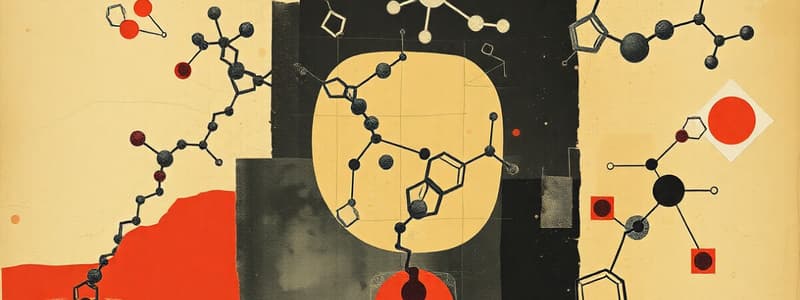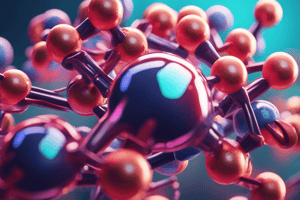Podcast
Questions and Answers
Which of the following amino acids is classified as a basic amino acid?
Which of the following amino acids is classified as a basic amino acid?
- Phenylalanine
- Histidine (correct)
- Methionine
- Aspartic acid
What distinguishes essential amino acids from non-essential amino acids?
What distinguishes essential amino acids from non-essential amino acids?
- Non-essential amino acids are only found in animal proteins.
- Essential amino acids can be synthesized by the body.
- Non-essential amino acids are not required for protein synthesis.
- Essential amino acids must be obtained from the diet. (correct)
Which of the following groups contains only non-polar amino acids?
Which of the following groups contains only non-polar amino acids?
- Aspartic acid, Glutamic acid, Tyrosine
- Threonine, Cysteine, Asparagine
- Glycine, Leucine, Serine
- Alanine, Valine, Isoleucine (correct)
Which structural feature is common to all amino acids?
Which structural feature is common to all amino acids?
What type of amino acids group together to form hydrogen bonds with water?
What type of amino acids group together to form hydrogen bonds with water?
Which of the following amino acids is classified within the category of aromatic amino acids?
Which of the following amino acids is classified within the category of aromatic amino acids?
How many amino acids are considered essential for human dietary needs?
How many amino acids are considered essential for human dietary needs?
What characteristic is used to classify amino acids as acidic?
What characteristic is used to classify amino acids as acidic?
Flashcards
What are amino acids?
What are amino acids?
Organic molecules that serve as the building blocks for proteins.
Structure of amino acid.
Structure of amino acid.
Each amino acid has a central carbon atom (alpha carbon) attached to four different groups: an amino group (NH2), a carboxyl group (COOH), a hydrogen atom (H), and a side chain (R group).
Types of amino acids.
Types of amino acids.
There are 20 different amino acids naturally found in living organisms.
Essential amino acids.
Essential amino acids.
Signup and view all the flashcards
Non-essential amino acids.
Non-essential amino acids.
Signup and view all the flashcards
Neutral amino acids.
Neutral amino acids.
Signup and view all the flashcards
Acidic amino acids.
Acidic amino acids.
Signup and view all the flashcards
Basic amino acids.
Basic amino acids.
Signup and view all the flashcards
Study Notes
Amino Acids
- Amino acids are organic molecules that are the building blocks of proteins.
- Approximately 300 amino acids exist naturally, but only 20 are used in protein synthesis.
- Amino acids comprise four different groups attached to a central carbon atom: an amino group, a carboxyl group, a hydrogen atom, and a side chain (R group).
- The R group distinguishes one amino acid from another, giving each unique properties.
- There are twenty different naturally occurring amino acids.
Amino Acid Classification
-
Amino acids are categorized into groups based on their side chains' properties.
-
Neutral amino acids: This is the largest group, further divided into:
- Aliphatic amino acids (e.g., glycine, valine, alanine, leucine, isoleucine)
- Aromatic amino acids (e.g., tyrosine, phenylalanine)
- Heterocyclic amino acids (e.g., tryptophan, histidine)
- Sulfur-containing amino acids (e.g., cysteine, methionine)
-
Acidic amino acids: (e.g., aspartic acid, glutamic acid)
-
Basic amino acids: (e.g., lysine, arginine)
-
Polar amino acids: are classified based on polarity of side chain (R):
-
OH group: serine, threonine, tyrosine
-
SH group: cysteine
-
amide group: glutamine and asparagine;
-
NH2 group or nitrogen act as a base (basic amino acids): lysine, arginine, histidine
-
COOH group (acidic amino acids): aspartic and glutamic
Essential and Nonessential Amino Acids
-
Essential amino acids: cannot be synthesized by the body and must be obtained from the diet.
- There are nine essential amino acids: phenylalanine, valine, tryptophan, threonine, isoleucine, methionine, histidine, leucine, and lysine.
-
Nonessential amino acids: can be synthesized by the body.
- There are eleven nonessential amino acids: alanine, arginine, asparagine, aspartic acid, cysteine, glutamic acid, glutamine, glycine, proline, serine, and tyrosine.
Functions of Amino Acids
- Beyond protein synthesis, amino acids have other roles:
- Some amino acids are converted to carbohydrates (glucogenic amino acids).
- Certain amino acids produce specialized products, including hormones (e.g., tyrosine forms thyroid hormones, epinephrine, and norepinephrine; tryptophan synthesizes niacin).
- Amino acids like glycine, arginine, and methionine synthesize creatine.
- Glycine and cysteine help in bile salt synthesis.
- Glutamate, cysteine, and glycine synthesize glutathione.
- Histidine converts to histamine through decarboxylation.
- Serotonin is formed from tryptophan.
- Glycine is used for heme synthesis.
Studying That Suits You
Use AI to generate personalized quizzes and flashcards to suit your learning preferences.





